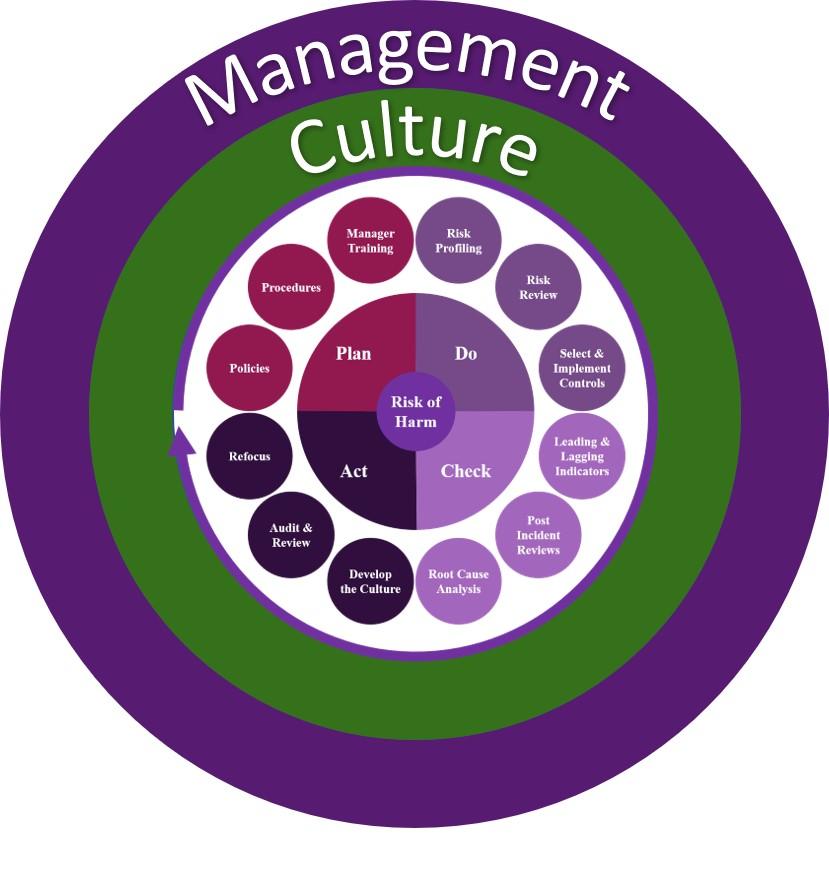In this series of articles, we will explore some of the key elements of an effective and proven work-related road risk management program, based on the well-known Health & Safety Management principles of Plan, Do, Check, Act, applied to work-related driving.

In this article, we look at some of the key steps to take in the Planning phase. It is important to remember that many stages in the process will interact and overlap with each other, so when developing your own program, it is important to consider all the elements rather than looking at anything in isolation.
Management and Culture
You will see from the illustration of what an effective and proven work-related road risk management process looks like that management and culture influence how all elements work. We will explore this in more detail when we discuss some of the key elements of the Plan phase. The important thing to remember here is that without the appropriate management support – from the senior leadership team down to your line managers and supervisors – and without the right on-road safety culture, then any program you put in place is unlikely to prove successful and/or sustainable at reducing your collision and claim rates.
Work-related road risk management - Plan
This is the start of the process, where you think about where you are now and what your aspirations are. You probably have some existing fleet safety and/or safe driving policies in place, and you need to decide where you want to improve and why.
Policies
In your policy documents, you should include:
-
What you want to achieve? This could be reducing the risk of harm to your employees and members of the public who they share the road with, improving your Corporate Social Responsibilities or minimising your risk of Health & Safety or Corporate Manslaughter prosecutions. It almost certainly will involve minimising financial losses from the direct and uninsured losses associated with collisions.
-
Who will be responsible for each element of the process? You should make sure that the roles and responsibilities are clearly defined, with managers accountable for each element of the program. You should also ensure that a senior manager is accountable for the entire program.
-
How you are going to achieve your aims? Here you should provide a high-level overview of the program.
-
How you will measure whether the program is a success? Outline here what you will me measuring, the Key Performance Indicators and your targets. These could include the number and severity of collisions and, if you have any leading indicators such as driver behaviour telemetry data, targets around this.
You should also make sure that your policies cover all areas of legal compliance. This will vary depending on which countries you operate in and what types of vehicle you are using. Legal compliance should be seen as an absolute minimum requirement, and rarely equates to current safe driving good or best practice.
Your policies should also anticipate change and include mechanisms for review and updating whenever there are fundamental changes in your organisation, the operating environment or the Law.
Essentially you are making it clear to everyone in the organisation (so the policy needs to be effectively and clearly communicated to all employees) what you are doing and why.
Procedures
Based on your work-related road risk management policies, you will need some procedures to bring these to life, which help employees understand what is required from them when they are making work-related road journeys and also when they are making private journeys in a company owned or leased vehicle.
It is beyond the scope of this article to go into any depth here, but the following areas should be addressed either in your procedures or a driver handbook:
-
Authorisation to drive (including licence checking)
-
Driver responsibilities & safe driving
-
Driver wellbeing
-
Journey management
-
Specific risk areas including sections covering:
-
Speeding
-
Distractions
-
Fatigue
-
Impairment
-
Staying safe in the event of a collision or breakdown
-
Personal security
-
Vehicle safety
-
Safety specifications
-
Checking & maintenance
If you operate larger and/or specialist vehicles, you will need to include specific policies to address the risks associated with their use (e.g. towing).
Manager training
This is a critical element of any effective work-related road risk management program, but one that many organisations overlook. An employees’ Line Manager or Supervisor has a big influence over how they drive.
Effectively, the Line Manager is the ‘controlling mind’ over the driver, and as such they are usually the best placed to interact with the employee regarding the overall driver safety program. It’s also important that managers are seen to be driving safely and following your policies and procedures.
Line Managers should understand the risks associated with making work-related road journeys, what your work-related road risk management program looks like, and their roles and responsibilities in administering the program and managing the safety of their direct reports. They also need to know how to effectively engage with their employees to talk about safe driving, and how to conduct post-incident debriefs to understand root causes. As most Line Managers will not have the knowledge or necessary skill set to do this, it is essential that you provide the appropriate training and support.
Having a strong on-road safety culture is one of the key success factors in any effective work-related road risk management program. How your Line Managers choose to drive, follow your rules and, critically, and how they engage with their employees when discussing the program and talking about road safety issues, on an on-going basis, goes a long way towards determining how quickly and effectively your on-road safety culture develops. If managers turn a blind eye towards identified issues, or are seen to be breaking the rules, how is your road safety initiative going to be taken seriously?
Summary
The planning phase of the work-related road risk management process will provide you with the framework for your entire program, so its an important step to get right. Your policies and procedures should reflect your aspirations but also your safety-operational balance. Remember that it is often necessary to modify your operating practices and procedures to create an environment in which employees are able to drive safely, rather than just tackle this through safe driving policies and procedures.
Line Managers and Supervisors play a crucial role in the effectiveness of your road safety program, and should be at the heart of it, engaging with employees on a regular basis, being seen to drive safely and follow the rules, and ultimately helping to develop the on-road safety culture.







